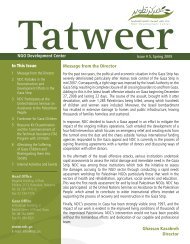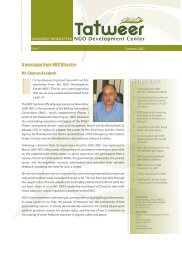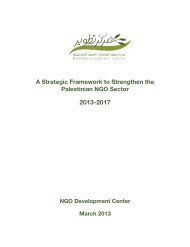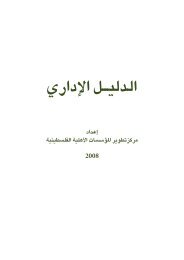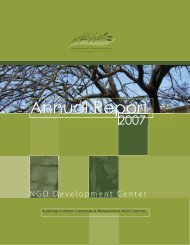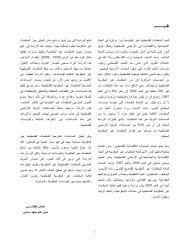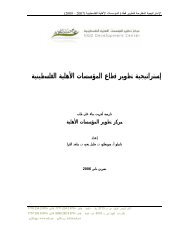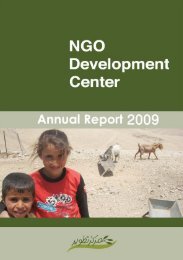Tracking External Donor Funding.pdf - NDC
Tracking External Donor Funding.pdf - NDC
Tracking External Donor Funding.pdf - NDC
You also want an ePaper? Increase the reach of your titles
YUMPU automatically turns print PDFs into web optimized ePapers that Google loves.
2.2.6.4 <strong>External</strong> Aid per capita in the WB&GS<br />
Figure 10 shows the fluctuations in the amount of<br />
external aid to Palestinians in the WB&GS on a per<br />
capita basis. There is a dramatic rise beginning in 2000<br />
and culminating at the height of the 2002 Intifada, and a<br />
similar pattern emerging in between the 2006 elections<br />
and the 2007 advent of the Emergency Government.<br />
Between 2000 and 2002, and between 2006 and 2008,<br />
the level of external aid on a per capita basis more than<br />
doubles (219 to 518 and 405 to 848 respectively).<br />
Figure 10: <strong>External</strong> Aid Per Capita<br />
to the WB&GS (1999-2008)<br />
900<br />
848<br />
800<br />
700<br />
600<br />
500<br />
400<br />
300<br />
200<br />
100<br />
0<br />
518<br />
506<br />
405<br />
288<br />
301<br />
333 322<br />
183<br />
219<br />
1999 2000 2001 2002 2003 2004 2005 2006 2007 2008<br />
Source: Table drawn from OECD/DAC and World Bank Databases (2009) and the<br />
PCBS (2009). Figures are given in USD.<br />
2.3 <strong>External</strong> Aid Coordination Structure<br />
As a result of the almost unprecedented amount of aid<br />
being channeled to the WB&GS and the highly<br />
politicized conditions in which it is delivered, a complex<br />
structure governing external aid has developed. The<br />
following section briefly maps the structure and<br />
evolution of this system, as well as its influence on the<br />
direction of external aid system. As these bodies<br />
represent the macro-level decision makers and<br />
stakeholders in the Palestinian development process, how<br />
and what decisions they make have an effect on external<br />
funding to PNGOs, which are only a small part of the<br />
bigger picture of externally financed development.<br />
2.3.1 Capital Level Aid Coordination<br />
As figure 2.3.1 shows, the external aid coordination<br />
structure is divided into two levels, the capital and the<br />
local. At the capital level are the major donor bodies,<br />
represented by the Quartet, EU, US, Russia and the UN.<br />
These players liaise with the Ad-Hoc Liaison Committee<br />
(AHLC), a 12-member committee, established on the 1 st<br />
of October 1993 by the Multilateral Steering Group of<br />
the multilateral talks on Middle East peace in the context<br />
of the Washington Conference. The AHLC serves as the<br />
principal policy-level coordination mechanism for<br />
development assistance to the Palestinian people and<br />
seeks to promote dialogue between donors, the<br />
Palestinian Authority (PA) and the Government of Israel<br />
(GoI). The AHLC is chaired by Norway and cosponsored<br />
by the EU and US. Its members include<br />
Russia, the EU, Japan, Canada and Saudi Arabia, while<br />
the PA, Israel, Egypt, Jordan and Tunisia are associate<br />
members. The World Bank acts as the Secretariat of the<br />
body.<br />
According to Brynen (2000:3), the AHLC acts as a 'sort<br />
of political steering committee, responsible for the<br />
overall guidelines and policies of the aid process, with all<br />
decisions made by consensus.<br />
The Joint Liaison Committee (JLC) follows up on<br />
AHLC decisions and recommendations at the local level,<br />
in between meetings of the AHLC, which are usually<br />
held twice a year (spring and autumn). The JLC was<br />
originally created in 1995 to enhance ‘tripartite’<br />
cooperation with the understanding that implementation<br />
18


